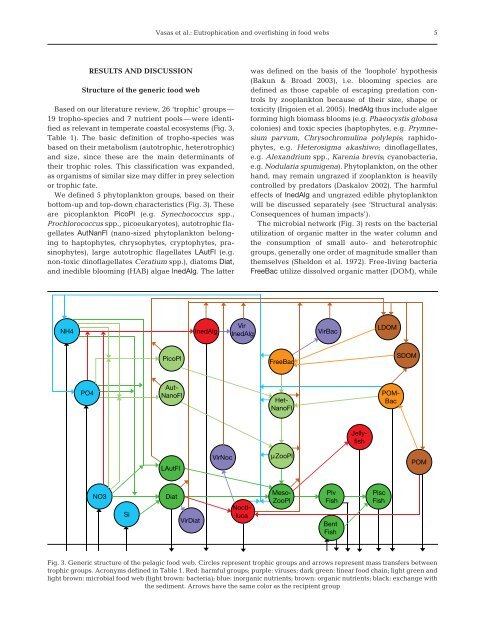Eutrophication and overfishing in temperate nearshore pelagic food
Eutrophication and overfishing in temperate nearshore pelagic food
Eutrophication and overfishing in temperate nearshore pelagic food
- No tags were found...
Create successful ePaper yourself
Turn your PDF publications into a flip-book with our unique Google optimized e-Paper software.
Vasas et al.: <strong>Eutrophication</strong> <strong>and</strong> <strong>overfish<strong>in</strong>g</strong> <strong>in</strong> <strong>food</strong> webs5RESULTS AND DISCUSSIONStructure of the generic <strong>food</strong> webBased on our literature review, 26 ‘trophic’ groups—19 tropho-species <strong>and</strong> 7 nutrient pools—were identifiedas relevant <strong>in</strong> <strong>temperate</strong> coastal ecosystems (Fig. 3,Table 1). The basic def<strong>in</strong>ition of tropho-species wasbased on their metabolism (autotrophic, heterotrophic)<strong>and</strong> size, s<strong>in</strong>ce these are the ma<strong>in</strong> determ<strong>in</strong>ants oftheir trophic roles. This classification was exp<strong>and</strong>ed,as organisms of similar size may differ <strong>in</strong> prey selectionor trophic fate.We def<strong>in</strong>ed 5 phytoplankton groups, based on theirbottom-up <strong>and</strong> top-down characteristics (Fig. 3). Theseare picoplankton PicoPl (e.g. Synechococcus spp.,Prochlorococcus spp., picoeukaryotes), autotrophic flagellatesAutNanFl (nano-sized phytoplankton belong<strong>in</strong>gto haptophytes, chrysophytes, cryptophytes, pras<strong>in</strong>ophytes),large autotrophic flagellates LAutFl (e.g.non-toxic d<strong>in</strong>oflagellates Ceratium spp.), diatoms Diat,<strong>and</strong> <strong>in</strong>edible bloom<strong>in</strong>g (HAB) algae InedAlg. The latterwas def<strong>in</strong>ed on the basis of the ‘loophole’ hypothesis(Bakun & Broad 2003), i.e. bloom<strong>in</strong>g species aredef<strong>in</strong>ed as those capable of escap<strong>in</strong>g predation controlsby zooplankton because of their size, shape ortoxicity (Irigoien et al. 2005). InedAlg thus <strong>in</strong>clude algaeform<strong>in</strong>g high biomass blooms (e.g. Phaeocystis globosacolonies) <strong>and</strong> toxic species (haptophytes, e.g. Prymnesiumparvum, Chrysochromul<strong>in</strong>a polylepis; raphidophytes,e.g. Heterosigma akashiwo; d<strong>in</strong>oflagellates,e.g. Alex<strong>and</strong>rium spp., Karenia brevis; cyanobacteria,e.g. Nodularia spumigena). Phytoplankton, on the otherh<strong>and</strong>, may rema<strong>in</strong> ungrazed if zooplankton is heavilycontrolled by predators (Daskalov 2002). The harmfuleffects of InedAlg <strong>and</strong> ungrazed edible phytoplanktonwill be discussed separately (see ‘Structural analysis:Consequences of human impacts’).The microbial network (Fig. 3) rests on the bacterialutilization of organic matter <strong>in</strong> the water column <strong>and</strong>the consumption of small auto- <strong>and</strong> heterotrophicgroups, generally one order of magnitude smaller thanthemselves (Sheldon et al. 1972). Free-liv<strong>in</strong>g bacteriaFreeBac utilize dissolved organic matter (DOM), whileNH4InedAlgVirInedAlgVirBacLDOMPicoPlFreeBacSDOMPO4Aut-NanoFlHet-NanoFlPOM-BacJellyfishLAutFlVirNocµZooPlPOMNO3SiDiatVirDiatNoctilucaMeso-ZooPlPlvFishBentFishPiscFishFig. 3. Generic structure of the <strong>pelagic</strong> <strong>food</strong> web. Circles represent trophic groups <strong>and</strong> arrows represent mass transfers betweentrophic groups. Acronyms def<strong>in</strong>ed <strong>in</strong> Table 1. Red: harmful groups; purple: viruses; dark green: l<strong>in</strong>ear <strong>food</strong> cha<strong>in</strong>; light green <strong>and</strong>light brown: microbial <strong>food</strong> web (light brown: bacteria); blue: <strong>in</strong>organic nutrients; brown: organic nutrients; black: exchange withthe sediment. Arrows have the same color as the recipient group
















